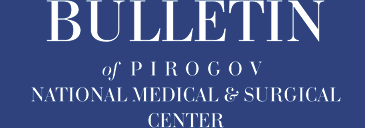Authors
Krajnyukov P.E.1, Pahomova R.A.2, Kokorin V.V.1, 3, Antonov M.V.4, Kochetova L.V.5, Kolesnik V.Yа.4
1 Central Military Clinical Hospital. P.V. Mandryka, Moscow
2 Russian Biotechnology University (ROSBIOTECH), Moscow
3 Pirogov National Medical and Surgical Center, Moscow
4 Chief military clinical hospital named after academic N.N. Burdenko, Moscow
5 Voino-Yasenetsky Krasnoyarsk State Medical University, Krasnoyarsk
Abstract
Autotransplantation of adipose tissue becomes a promising method in the treatment of deep wounds with muscle damage and exposure of neurovascular structures, especially against the background of chronic ischemia and venous insufficiency. The necessity of the regenerative approach was the reason for the present study.
Aims. To investigate the effectiveness of primary closure of deep wounds of the lower limbs using the modified autograft of the own adipose tissue obtained from the distant donor zones in order to accelerate the reparative processes, to prevent the formation of pathological scars and to achieve the optimal aesthetic result.
Materials and methods. We compared 2 adipose tissue samples placed in solutions with different chemical content for each group (0.9% NaCl solution, 15% dimethyloxobutylphosphonyl dimethylate solution), with exposure for 5 hours and evaluation of ionic composition by electron microscopy in low vacuum and energy dispersive X-ray spectral analysis (EDX) with evaluation of potential cell viability. A clinical case is described in which autotransplantation of adipose tissue was performed in a patient with a gaping wound of the lower limb after primary surgical treatment of the wound surface under intravenous sedation and local anesthesia on the 3rd day.
Results. The viability of fat cells can be improved by modifying the microenvironment with artificial solutions. The effectiveness of the surgical method was confirmed in practice – on the 7th day there was a complete closure of the wound defect with the formation of a stable skin cover. The subsequent restoration of the skin cover was carried out by secondary tension on the base represented by the transplanted fat tissue (“subcutaneous base” – according to the modern anatomical terminology).
Conclusion. Autotransplantation of adipose tissue is an effective technique for primary closure of deep soft tissue defects characterized by a high level of safety and a favorable potential for further recovery. Clinical observations confirm the prospectivity of this approach with the further possibility of improving the effectiveness of the method.
Keywords: autotransplantation, adipose tissue, wound, reconstructive surgery.
References
1. Lee P, Krisht KM, Cai L, Krisht AF. Autologous Temporalis Subfascial Fat Graft for Skull Base Repair: A Novel Technique. Oper Neurosurg (Hagerstown). 2021; 20(4): E274-E278. doi: 10.1093/ons/opaa442.
2. Zakharov PD, Nikitin AS. Barrier methods of epidural fibrosis prevention at the lumbar level after microdiscectomy. Vestnik nevrologii, psikhiatrii i nejrokhirurgii. 2024; 17(1): 9-20. (In Russ.) doi: 10.33920/med-01-2401-01.
3. Misbakhova AR, Manturova NE, Murashkin NN, Stenko AG. Application of autologous adipose tissue (lipofilling) in the treatment of linear scleroderma (literature review). Meditsinskiy alfavit. 2020; 24: 15-17. (In Russ.) doi: 10.33667/2078-5631-2020-24-15-17.
4. Misbakhova AR, Manturova NE, Kruglova LS. Application of lipofilling in the treatment of linear scleroderma of the “saber blow” type in a child. Effektivnaya farmakoterapiya. 2024; 20(28): 98-100. (In Russ.) doi: 10.33978/2307-3586-2024-20-28-98-100.
5. d’Avella E, Solari D, De Rosa A, et al. The Fate of Fat Graft in Extended Endoscopic Transtuberculum-Transplanum Approaches. World Neurosurg. 2022; 167: e590-e599. doi: 10.1016/j.wneu.2022.08.059.
6. Yang S, Sun Y, Yan C. Recent advances in the use of extracellular vesicles from adipose-derived stem cells for regenerative medical therapeutics. J Nanobiotechnology. 2024; 22(1): 316. doi: 10.1186/s12951-024-02603-4.
7. Zhang Y, Liu T. Adipose-derived stem cells exosome and its potential applications in autologous fat grafting. J Plast Reconstr Aesthet Surg. 2023; 76: 219-229. doi: 10.1016/j.bjps.2022.10.050.
8. Qin Y, Ge G, Yang P, et al. An Update on Adipose-Derived Stem Cells for Regenerative Medicine: Where Challenge Meets Opportunity. Adv Sci (Weinh). 2023; 10(20): e2207334. doi: 10.1002/advs.202207334.
9. Challapalli RS, Dwyer RM, McInerney N, Kerin MJ, Lowery AJ. Effect of Breast Cancer and Adjuvant Therapy on Adipose-Derived Stromal Cells: Implications for the Role of ADSCs in Regenerative Strategies for Breast Reconstruction. Stem Cell Rev Rep. 2021; 17(2): 523-538. doi: 10.1007/s12015-020-10038-1.
10. Yuan C, Song W, Jiang X, et al. Adipose-derived stem cell-based optimization strategies for musculoskeletal regeneration: recent advances and perspectives. Stem Cell Res Ther. 2024; 15(1): 91. doi: 10.1186/s13287-024-03703-6.
11. An Y, Lin S, Tan X, Zhu S, Nie F, Zhen Y, et al. Exosomes from adipose-derived stem cells and application to skin wound healing. Cell Prolif. 2021; 54(3): e12993. doi: 10.1111/cpr.12993.
12. Ekstein SF, Wyles SP, Moran SL, Meves A. Keloids: a review of therapeutic management. Int J Dermatol. 2021; 60(6): 661-671. doi: 10.1111/ijd.15159.
13. Raktoe R, Kwee AKAL, Rietveld M, et al. Mimicking fat grafting of fibrotic scars using 3D-organotypic skin cultures. Exp Dermatol. 2023; 32(10): 1752-1762. doi: 10.1111/exd.14893.
14. Cuomo R, Giardino FR, Nisi G, et al. Fat graft for reducing pain in chronic wounds. Wound Repair Regen. 2020; 28(6): 780-788. doi: 10.1111/wrr.12846.
15. Kim DH, Kim DS, Ha HJ, et al. Fat Graft with Allograft Adipose Matrix and Magnesium Hydroxide-Incorporated PLGA Microspheres for Effective Soft Tissue Reconstruction. Tissue Eng Regen Med. 2022; 19(3): 553-563. doi: 10.1007/s13770-021-00426-0.


